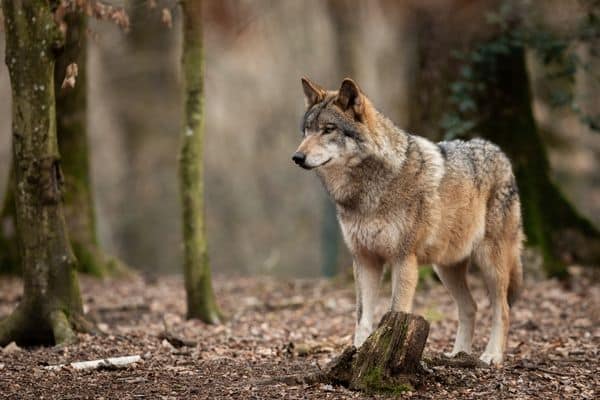The Greater Yellowstone Ecosystem is the only place in the lower 48 states where all the wildlife that called the region home before the arrival of Europeans still exists. The largest wild bison herd in the country, the largest elk herds in North America, and a rare population of grizzly bears all roam freely in these National Parks.
Hundreds of species of birds also live here, including trumpeter swans, blue herons, western tanagers and the iconic bald eagle. Throw in wolves, coyotes, and cougars, and the painting starts to take shape. Spring and early summer in Yellowstone and Grand Teton National Parks welcome bear cubs, bison calves, wolf pups and elk calves. Pronghorn and elk herds also migrate from lower elevations outside the parks to the higher Lamar Valley, Cascade Meadows, Willow Flats and Jenny Lake.
Find out more about the animals of America’s Serengeti and the places Classic Journeys takes you to see wildlife while on an adventure in the west.
Grizzly and Black Bears

More than 700 grizzly bears live in the Greater Yellowstone Ecosystem, one of the most significant populations found in the United States outside of Alaska. Black bears number over 600, and both species are an extraordinary sight in the wild. Oxbow Bend in the Tetons, Yellowstone’s Lamar and Hyden Valleys, and Lake Yellowstone often give way to encounters at a distance.
Simply known as #399, a mama grizzly seen in and around Grand Teton National Park is a local and international celebrity. Weighing in at around 400 pounds and almost 7ft when standing on her hind legs, she has put a face to the importance of continuing conservation efforts in and around our national parks. At 26 years of age, #399 is one of the oldest grizzly bears in the region. She’s had four liters of cubs including triplets and quadruplets, a rare occurrence that has put her sleuth on the top of many travelers’ bucket lists to see while visiting.
Black bears make more appearances than their illustrious counterparts, found at many sites that Classic Journeys visit, including Mammoth Hot Springs and the lakes and rivers of both parks. They are adept climbers and are sometimes seen fishing in the morning or evening, a welcome surprise for those who are lucky enough to see it.
Bison

The bison of the United States capture the imagination of travelers far and wide, and the herds found in the Greater Yellowstone Ecosystem come from a lineage that dates back to prehistoric times. Two herds currently live in Yellowstone’s valleys, with Lamar Valley hosting the biggest number, representing a scene that early explorers might have come across before the species was hunted to near extinction.
American Bison are the largest land mammal in North America, weighing as much as 2000 pounds and capable of reaching speeds of 40 mph. More than likely, the gingerly giants amble across meadows and sometimes roads, causing an impromptu photo opportunity while waiting for the multitudes to cross!
Birds of a Feather

Bald Eagles: Ensconced in the Greater Yellowstone Ecosystem and often seen in the skies above the Hayden Valley, Yellowstone Lake and Grand Teton’s Oxbow Bend; bald eagles stand out amid the region’s other birds of prey. While osprey, hawks and owls certainly find their place on the list, watching bald eagles swoop down to fish in the waters below makes an impression that’s hard to beat. There currently are about 29 nesting pairs of bald eagles in Yellowstone National Park, and combined with golden eagles, the region is home to the largest concentration of eagles in the continental United States.
Trumpeter Swans: A Yellowstone success story, the Trumpeter Swans found along the banks and wetlands of the area’s lakes and rivers are the result of a conservation program started after the North American population fell to 70 individuals in the 1930s. The small group of remaining swans lived inside Yellowstone’s borders and became the pool for repopulating the continent’s population of more than 60,000 today. The numbers are on the rise, having had ups and downs, with the current population residing at around 30 in the summer and growing to almost 400 in the winter. The birds that migrate flock to the area to nest along the unfrozen waters of the region.
Songbirds: The arrival of Western Tanager signals spring in the Greater Yellowstone Ecosystem. Coming from as far away as Argentina to nest and mate, their red, orange, yellow, and black plumage are easy to spot in the open forests of the parks. More annual songbirds that add color to a day’s excursions include Audubon’s warblers, bluebirds, and yellow-breasted meadowlarks whose songs, warbles and mating calls accentuate the air while out and about.
Pronghorn and Elk

When in residence between their spring and early winter migrations, pronghorn and elk in the Greater Yellowstone Ecosystem make an impression of their own on those who explore with Classic Journeys. Seen frequently in and around the valleys of Yellowstone, elks make their presence known most notably in the fall. Males bugle to impress mates and signal their presence to other bulls, often heard in the early morning or after the sun sets.
Grand Teton National Park’s Sagebrush Flats is a popular hangout for pronghorn, who head to the park’s higher elevations in the spring along the Path of the Pronghorn. The journey of more than a hundred miles is arduous. The sleek animals are almost as fast as cheetahs, but not anywhere near as nimble. Recent efforts to clear the ancient route of fences and manmade obstacles have helped make way for the continued presence of pronghorns in the park.
Wolves, Coyotes, and Cougars

The grey wolves of Yellowstone were hunted to extinction in the 1920s as part of a plan to protect livestock and other animals in and around the park. The National Park Service reintroduced wolves to the region in 1996, and today there are over a hundred individuals separated into nine different packs inside Yellowstone National Park, and more than 500 in the Greater Yellowstone Ecosystem.
The number of coyotes in the region blossomed after the wolves were removed, filling a niche left open by the latter’s absence. With the renewed population of grey wolves, the number of coyotes has declined in turn. Cougars, or mountain lions, fell to a similar fate to that of the wolf. Effectively wiped out in Yellowstone and the surrounding areas, a small population survived in the neighboring states, and they have since been repatriated to the area. Today all three call Yellowstone and the Tetons home, most often seen skirting the valleys and forests around that of their prey, namely elk, pronghorn, and bison.
Are you ready to spot wildlife with an expert local guide? Join Classic Journeys, on foot and at eye level, as we explore Yellowstone and Grand Teton National Parks.





